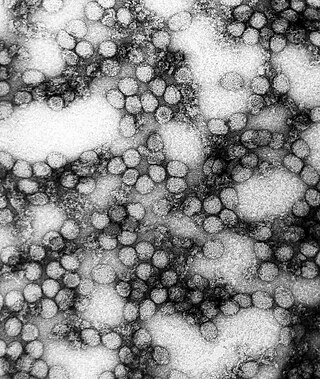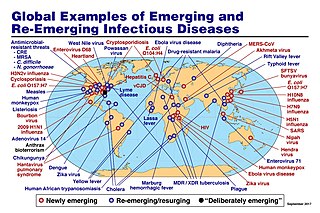Related Research Articles
A human pathogen is a pathogen that causes disease in humans.

Yellow fever is a viral disease of typically short duration. In most cases, symptoms include fever, chills, loss of appetite, nausea, muscle pains – particularly in the back – and headaches. Symptoms typically improve within five days. In about 15% of people, within a day of improving the fever comes back, abdominal pain occurs, and liver damage begins causing yellow skin. If this occurs, the risk of bleeding and kidney problems is increased.

Yersinia pestis is a gram-negative, non-motile, coccobacillus bacterium without spores that is related to both Yersinia pseudotuberculosis and Yersinia enterocolitica. It is a facultative anaerobic organism that can infect humans via the Oriental rat flea. It causes the disease plague, which caused the first plague pandemic and the Black Death, the deadliest pandemic in recorded history. Plague takes three main forms: pneumonic, septicemic, and bubonic. Yersinia pestis is a parasite of its host, the rat flea, which is also a parasite of rats, hence Y. pestis is a hyperparasite.

A zoonosis or zoonotic disease is an infectious disease of humans caused by a pathogen that can jump from a non-human to a human and vice versa.

Yersinia is a genus of bacteria in the family Yersiniaceae. Yersinia species are Gram-negative, coccobacilli bacteria, a few micrometers long and fractions of a micrometer in diameter, and are facultative anaerobes. Some members of Yersinia are pathogenic in humans; in particular, Y. pestis is the causative agent of the plague. Rodents are the natural reservoirs of Yersinia; less frequently, other mammals serve as the host. Infection may occur either through blood or in an alimentary fashion, occasionally via consumption of food products contaminated with infected urine or feces.

Trichinosis, also known as trichinellosis, is a parasitic disease caused by roundworms of the Trichinella type. During the initial infection, invasion of the intestines can result in diarrhea, abdominal pain, and vomiting. Migration of larvae to muscle, which occurs about a week after being infected, can cause swelling of the face, inflammation of the whites of the eyes, fever, muscle pains, and a rash. Minor infection may be without symptoms. Complications may include inflammation of heart muscle, central nervous system involvement, and inflammation of the lungs.

In infectious disease ecology and epidemiology, a natural reservoir, also known as a disease reservoir or a reservoir of infection, is the population of organisms or the specific environment in which an infectious pathogen naturally lives and reproduces, or upon which the pathogen primarily depends for its survival. A reservoir is usually a living host of a certain species, such as an animal or a plant, inside of which a pathogen survives, often without causing disease for the reservoir itself. By some definitions a reservoir may also be an environment external to an organism, such as a volume of contaminated air or water.

An emerging infectious disease (EID) is an infectious disease whose incidence has increased recently, and could increase in the near future. The minority that are capable of developing efficient transmission between humans can become major public and global concerns as potential causes of epidemics or pandemics. Their many impacts can be economic and societal, as well as clinical. EIDs have been increasing steadily since at least 1940. For every decade since 1940, there has been a consistent increase in the number of EID events from wildlife-related zoonosis. Human activity is the primary driver of this increase, with loss of biodiversity a leading mechanism.
An emergent virus is a virus that is either newly appeared, notably increasing in incidence/geographic range or has the potential to increase in the near future. Emergent viruses are a leading cause of emerging infectious diseases and raise public health challenges globally, given their potential to cause outbreaks of disease which can lead to epidemics and pandemics. As well as causing disease, emergent viruses can also have severe economic implications. Recent examples include the SARS-related coronaviruses, which have caused the 2002-2004 outbreak of SARS (SARS-CoV-1) and the 2019–21 pandemic of COVID-19 (SARS-CoV-2). Other examples include the human immunodeficiency virus which causes HIV/AIDS; the viruses responsible for Ebola; the H5N1 influenza virus responsible for avian flu; and H1N1/09, which caused the 2009 swine flu pandemic. Viral emergence in humans is often a consequence of zoonosis, which involves a cross-species jump of a viral disease into humans from other animals. As zoonotic viruses exist in animal reservoirs, they are much more difficult to eradicate and can therefore establish persistent infections in human populations.
A reverse zoonosis, also known as a zooanthroponosis or anthroponosis, is a pathogen reservoired in humans that is capable of being transmitted to non-human animals.

In epidemiology, a disease vector is any living agent that carries and transmits an infectious pathogen to another living organism; agents regarded as vectors are organisms, such as parasites or microbes. The first major discovery of a disease vector came from Ronald Ross in 1897, who discovered the malaria pathogen when he dissected a mosquito.
Theories of the Black Death are a variety of explanations that have been advanced to explain the nature and transmission of the Black Death (1347–51). A number of epidemiologists from the 1980s to the 2000s challenged the traditional view that the Black Death was caused by plague based on the type and spread of the disease. The confirmation in 2010 and 2011 that Yersinia pestis DNA was associated with a large number of plague sites has led researchers to conclude that "Finally, plague is plague."
In biology, a pathogen, in the oldest and broadest sense, is any organism or agent that can produce disease. A pathogen may also be referred to as an infectious agent, or simply a germ.

Sylvatic plague is an infectious bacterial disease caused by the plague bacterium that primarily affects rodents, such as prairie dogs. It is the same bacterium that causes bubonic and pneumonic plague in humans. Sylvatic, or sylvan, means 'occurring in woodland,' and refers specifically to the form of plague in rural wildlife. Urban plague refers to the form in urban wildlife.

Urban plague is an infectious disease among rodent species that live in close association with humans in urban areas. It is caused by the bacterium Yersinia pestis which is the same bacterium that causes bubonic and pneumonic plague in humans. Plague was first introduced into the United States in 1900 by rat–infested steamships that had sailed from affected areas, mostly from Asia. Urban plague spread from urban rats to rural rodent species, especially among prairie dogs in the western United States.
Cross-species transmission (CST), also called interspecies transmission, host jump, or spillover, is the transmission of an infectious pathogen, such as a virus, between hosts belonging to different species. Once introduced into an individual of a new host species, the pathogen may cause disease for the new host and/or acquire the ability to infect other individuals of the same species, allowing it to spread through the new host population. The phenomenon is most commonly studied in virology, but cross-species transmission may also occur with bacterial pathogens or other types of microorganisms.
Raccoonpox virus (RCN) is a double-stranded DNA virus and a member of the orthopoxviruses in the family Poxviridae and subfamily Chordopoxvirinae which consists of eight genera: Avipoxvirus, Capripoxvirus, Leporipoxvirus, Molluscipoxvirus, Orthopoxvirus, Parapoxvirus, Suipoxvirus and Yatapoxvirus Vertebrates are the natural host of Chordopoxvirinae subfamily viruses. More specifically, raccoons are the natural hosts of RCN. RCN was isolated in 1961 from the upper respiratory tissues of 2 raccoons in a group of 92 observably healthy raccoons trapped close to Aberdeen, Maryland.
The Neolithic decline was a rapid collapse in populations between 5000 and 6000 years ago during the Neolithic period in western Eurasia. The specific causes of that broad population decline are still debated. While heavily populated settlements were regularly created, abandoned, and resettled during the Neolithic, after around 5400 years ago, a great number of those settlements were permanently abandoned. The population decline is associated with worsening agricultural conditions and a decrease in cereal production. Other suggested causes include the emergence of communicable diseases spread from animals living in close quarters with humans.

Global climate change has resulted in a wide range of impacts on the spread of infectious diseases. Like other climate change impacts on human health, climate change exacerbates existing inequalities and challenges in managing infectious disease. Infectious diseases whose transmission can be impacted by climate change include dengue fever, malaria, tick-borne diseases, leishmaniasis and Ebola virus disease. For example, climate change is altering the geographic range and seasonality of the mosquito that can carry dengue.
Human-to-human transmission (HHT) is an epidemiologic vector, especially in case the disease is borne by individuals known as superspreaders. In these cases, the basic reproduction number of the virus, which is the average number of additional people that a single case will infect without any preventative measures, can be as high as 203.9. Interhuman transmission is a synonym for HHT.
References
- 1 2 Fernandes O, Mangia RH, Lisboa CV, et al. (1999). "The complexity of the sylvatic cycle of Trypanosoma cruzi in Rio de Janeiro state (Brazil) revealed by the non-transcribed spacer of the mini-exon gene". Parasitology. 118 (2): 161–6. doi:10.1017/s0031182098003709. PMID 10028530. S2CID 2124778.
- 1 2 Plague: Yersinia pestis Archived 2008-01-13 at the Wayback Machine
- ↑ Schmitt N, Saville JM, Greenway JA, Stovell PL, Friis L, Hole L (1978). "Sylvatic trichinosis in British Columbia: potential threat to human health from an independent cycle". Public Health Rep. 93 (2): 189–93. PMC 1431877 . PMID 635095.
- ↑ Vasilakis N, Holmes EC, Fokam EB, et al. (2007). "Evolutionary processes among sylvatic dengue type 2 viruses". J. Virol. 81 (17): 9591–5. doi:10.1128/JVI.02776-06. PMC 1951459 . PMID 17553878.
- ↑ "EPIDEMIOLOGY OF CHAGAS DISEASE". www.dbbm.fiocruz.br.
- ↑ Sudhi Ranjan Garg (2013). Rabies in Man and Animals. Springer Science & Business Media. p. 15. ISBN 9788132216056.